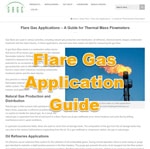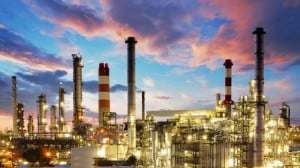There are applications thermal mass flow meters assist within the chemical and petrochemical industries, including flare gas and flue gas monitoring, scrubber balancing, and nitrogen blanketing.
- Flare Gas
- Direct Mass Flow Measurement
- Ultra-low Velocity Measurement
- Rugged Sensor
- Fast Response
- Flue Gas/Headers
- Scrubber Balancing
- Nitrogen Blanketing
Flare Gas Monitoring
 Flare gas monitoring presents multiple application challenges and can be problematic, partly due to wide variations in flow rate. The normal flow rate to the flare is zero, but when the pressure in the separator vents to the flare, the flow rate instantly increases and then declines to zero as the pressure is relieved. Also, temperatures and gas composition can vary dramatically.
Flare gas monitoring presents multiple application challenges and can be problematic, partly due to wide variations in flow rate. The normal flow rate to the flare is zero, but when the pressure in the separator vents to the flare, the flow rate instantly increases and then declines to zero as the pressure is relieved. Also, temperatures and gas composition can vary dramatically.
Sage thermal mass flow meters are ideal for the following reasons:
-
- The Sage meter provides direct mass flow measurement so there is no need for external temperature or pressure correction.
- Unlike some other brands, Sage meters can measure velocities as low as 10 SFPM or as high as 40,000 SFPM, or higher with a specialized shield. This wide rangeability is critical for flare gas measurements. Sage can calibrate for two extreme conditions – one channel for the vent gas and another for the upset state, and the customer’s system can automatically switch channels through a simple contact closure on the terminals.
- Sage developed a more substantial, ¾” rugged sensor to withstand the challenging flare gas upset conditions.
- Sage meters have a quick, less than two seconds, response time to changes in flow rate, unlike constant power devices that measure temperature change and have limitations at low flow.
More information is available on The Challenges and Solutions of Flare Gas Metering.

Monitor Flue Gas / Headers
Flue gases, those gases from various processes that exit a flue to the atmosphere, can be monitored using thermal mass flow meters. Also, the different header pipes leading to the main exhaust stack may be tracked individually to alarm for upset conditions within the process.
Scrubber Balancing
Various types of scrubbers clean emission gases before discharged into the atmosphere. Installing thermal mass flow meters at multiple points in the scrubber systems can monitor flow rates and determine efficiencies.
Nitrogen Blanketing
Nitrogen blanketing is used in large tanks to prevent the contents from coming into contact with air. Thermal mass flow meters monitor nitrogen flow and can check for leaks in these applications.
For more information, our white paper, “Flare Gas Measurement Using Thermal Mass Flow Meters” explores gas flaring and overcoming measurement challenges using thermal mass flow meters.
Image by Rudy and Peter Skitterians from Pixabay

